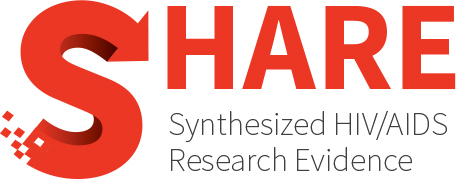Category Archives: Children or Youth (less than 18 years old)
HIV sexual risk-reduction interventions for youth: A review and methodological critique of randomized controlled trials
The authors review and provide a methodological critique of randomized controlled studies of HIV risk reduction interventions that measured sexual risk behavior outcomes with adolescents. Studies conducted in school, community,...
Meta-analysis of published studies or meta-analysis of individual data? Caesarean section in HIV-positive women as a study case
Very few comparative evaluations of meta-analysis of published data and meta-analysis using individual patient data have appeared in the medical literature. The association between type of delivery and HIV perinatal...
Safety of tenofovir during pregnancy for the mother and fetus: A systematic review
Tenofovir disoproxil fumarate (TDF) safety during pregnancy has important public health implications. This review summarizes TDF safety during pregnancy, focusing on pregnancy outcomes, congenital anomaly risk, and other potential toxicities...
Experiences integrating delivery of maternal and child health services with childhood immunization programs: Systematic review update
BACKGROUND: The World Health Organization and the United Nations Children’s Fund promote integration of maternal and child health (MCH) and immunization services as a strategy to strengthen immunization programs. We...
Awareness and knowledge of sexually transmitted diseases (STDs) among school-going adolescents in Europe: A systematic review of published literature
BACKGROUND: Sexually transmitted diseases (STDs) are a major health problem affecting mostly young people, not only in developing, but also in developed countries.We conducted this systematic review to determine awareness...
Health outcomes associated with methamphetamine use among young people: A systematic review
OBJECTIVES: Methamphetamine (MA) use among young people is of significant social, economic and public health concern to affected communities and policy makers. While responses have focused upon various perceived severe...
Mannose-binding lectin and the risk of HIV transmission and disease progression in children: A systematic review
BACKGROUND: Mannose-binding lectin (MBL) can activate the complement system by binding to carbohydrates, such as those presented on the HIV virion surface. It is unclear whether genetically determined MBL deficiency...
Meta-analyses on behavioral interventions to reduce the risk of transmission of HIV
Different behavioral interventions have found to be efficacious in reducing high-risk sexual activity. Interventions have been evaluated in both original research and meta-analytic reviews. Most of the studies have shown...
Ethical and practical challenges in implementing informed consent in HIV/AIDS clinical trials in developing or resource-limited countries
BACKGROUND/RATIONALE: Ethical issues regarding HIV/AIDS human research in the developing world remain under continuous evaluation; a critical area of concern includes informed consent. This paper reviews several of the most...
